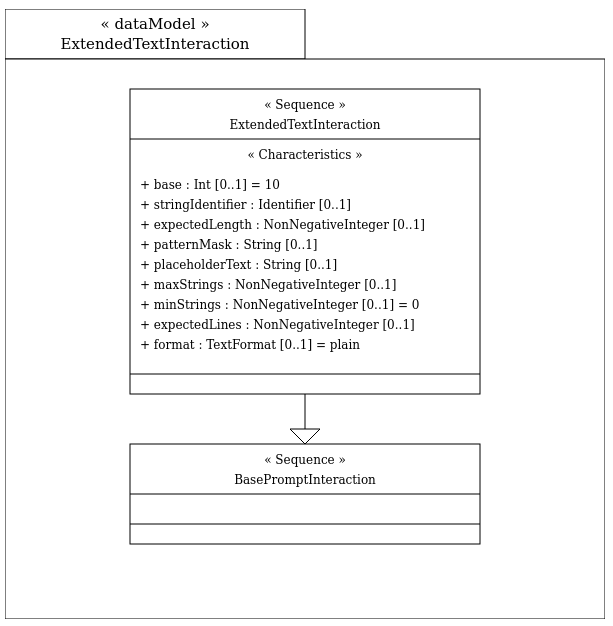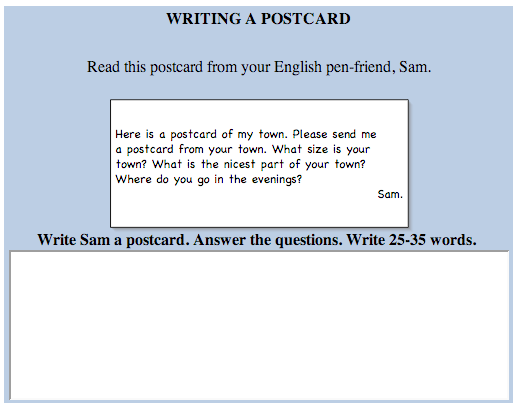Extended Text Interaction (QTI)
An extended text interaction is a blockInteraction that allows the candidate to enter an extended amount of text. The extendedTextInteraction must be bound to a response variable of single, multipe, ordered or record cardinality. If the response variable has record cardinality the fields in the records are ‘stringValue’ ‘floatValue’, etc. Otherwise it must have a baseType of string, integer or float. When bound to response variable with single cardinality a single string of text is required from the candidate. When bound to a response variable with multiple or ordered cardinality several separate text strings may be required, see maxStrings below. The relevant class is:
ExtendedTextInteraction is a String interactions and can be bound to numeric response variables, instead of strings, if desired. If detailed information about a numeric response is required then the string interaction can be bound to a response variable with record cardinality.
Data Model

Example

If an extended response is required from the candidate then the extendedTextInteraction is appropriate. Notice that this example does not contain a responseProcessing section because the scoring of extended text responses is beyond the scope of this specification.
<assessmentItem xsi:schemaLocation="http://www.imsglobal.org/xsd/imsqti_v2p2 http://www.imsglobal.org/xsd/qti/qtiv2p2/imsqti_v2p2p2.xsd" identifier="extendedText" title="Writing a Postcard" adaptive="false" timeDependent="false">
<responseDeclaration identifier="RESPONSE" cardinality="single" baseType="string"/>
<outcomeDeclaration identifier="SCORE" cardinality="single" baseType="float"/>
<itemBody>
<p>
Read this postcard from your English pen-friend, Sam.
</p>
<div>
<object type="image/png" data="images/postcard.png">
<blockquote class="postcard">
<p>
Here is a postcard of my town. Please send me
<br/>
a postcard from your town. What size is your
<br/>
town? What is the nicest part of your town?
<br/>
Where do you go in the evenings?
<br/>
Sam.
</p>
</blockquote>
</object>
</div>
<extendedTextInteraction responseIdentifier="RESPONSE" expectedLength="200">
<prompt>
Write Sam a postcard. Answer the questions. Write 25-35 words.
</prompt>
</extendedTextInteraction>
</itemBody>
</assessmentItem>
Example with rubric:
<assessmentItem
xsi:schemaLocation="http://www.imsglobal.org/xsd/imsqti_v2p2 http://www.imsglobal.org/xsd/qti/qtiv2p2/imsqti_v2p2p2.xsd"
identifier="extendedText"
title="Writing a Postcard with rubric"
adaptive="false"
timeDependent="false"
>
<responseDeclaration
identifier="RESPONSE"
cardinality="single"
baseType="string"
/>
<outcomeDeclaration
identifier="SCORE"
cardinality="single"
baseType="float"
/>
<itemBody>
<p>Read this postcard from your English pen-friend, Sam.</p>
<div>
<object type="image/png" data="images/postcard.png">
<blockquote class="postcard">
<p>
Here is a postcard of my town. Please send me
<br />
a postcard from your town. What size is your
<br />
town? What is the nicest part of your town?
<br />
Where do you go in the evenings?
<br />
Sam.
</p>
</blockquote>
</object>
</div>
<extendedTextInteraction
responseIdentifier="RESPONSE"
expectedLength="200"
>
<prompt>
Write Sam a postcard. Answer the questions. Write 25-35 words.
</prompt>
</extendedTextInteraction>
<rubricBlock view="scorer">
<h1>Scoring Guidelines</h1>
<div>
<p>
<b>Max Score:</b>
3.0 points
</p>
<p>
<b>Scoring:</b>
</p>
<ul>
<li>
When not all 3 questions are answered in the response:
-1 for each missing.
</li>
<li>Check for gramatical errors: -0.1 per error.</li>
<li>
Possibly add in .1 increments extra bonus points for
extra good answers.
</li>
</ul>
</div>
</rubricBlock>
</itemBody>
</assessmentItem>